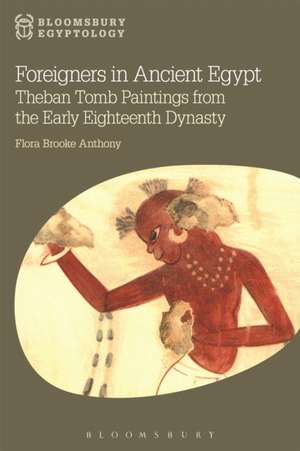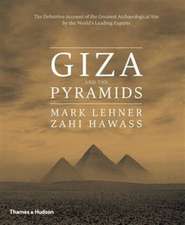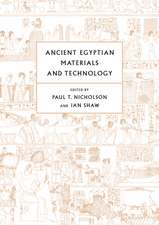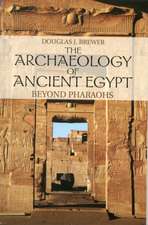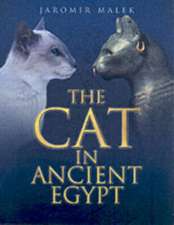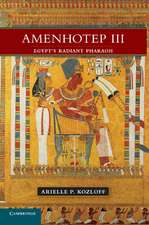Foreigners in Ancient Egypt: Theban Tomb Paintings from the Early Eighteenth Dynasty: Bloomsbury Egyptology
Autor Dr Flora Brooke Anthonyen Limba Engleză Hardback – 30 noi 2016
| Toate formatele și edițiile | Preț | Express |
|---|---|---|
| Paperback (1) | 200.00 lei 6-8 săpt. | |
| Bloomsbury Publishing – 30 noi 2016 | 200.00 lei 6-8 săpt. | |
| Hardback (1) | 714.12 lei 6-8 săpt. | |
| Bloomsbury Publishing – 30 noi 2016 | 714.12 lei 6-8 săpt. |
Preț: 714.12 lei
Preț vechi: 830.37 lei
-14% Nou
Puncte Express: 1071
Preț estimativ în valută:
136.69€ • 148.53$ • 114.89£
136.69€ • 148.53$ • 114.89£
Carte tipărită la comandă
Livrare economică 21 aprilie-05 mai
Preluare comenzi: 021 569.72.76
Specificații
ISBN-13: 9781474241588
ISBN-10: 1474241581
Pagini: 184
Ilustrații: 50 bw and 10 colour illus
Dimensiuni: 156 x 234 x 23 mm
Greutate: 0.45 kg
Editura: Bloomsbury Publishing
Colecția Bloomsbury Academic
Seria Bloomsbury Egyptology
Locul publicării:London, United Kingdom
ISBN-10: 1474241581
Pagini: 184
Ilustrații: 50 bw and 10 colour illus
Dimensiuni: 156 x 234 x 23 mm
Greutate: 0.45 kg
Editura: Bloomsbury Publishing
Colecția Bloomsbury Academic
Seria Bloomsbury Egyptology
Locul publicării:London, United Kingdom
Caracteristici
Presents readers with insight on how the ancient Egyptians viewed their world and their role within the cosmos in the light of their representations of foreigners
Notă biografică
Flora Brooke Anthony is Visiting Lecturer at Georgia State University, USA, where she teaches Art History and Egyptology. Her doctorate was from Emory University and she has received numerous awards and fellowships for her research on foreigners in ancient Egyptian paintings.
Cuprins
List of IllustrationsList of AbbreviationsAcknowledgementsPrefaceChapter 1 IntroductionChapter 2 BackgroundChapter 3 The Cosmic Significance of the Tomb Chapter 4 Foreigner Typologies Chapter 5 Palatial DecorationsChapter 6 Underlying Egyptian Concepts in the Tribute Scenes53Chapter 7 Funerary Symbolism in Tribute ScenesChapter 8 Between Symbolism and VeracityChapter 9 ConclusionsAppendix 1Appendix 2NotesBibliographyIndex
Recenzii
Illustrated throughout with black-and-white and colour images, with a comprehensive bibliography, this multi-faceted analysis successfully conveys the importance of evaluating ancient Egyptian decorative motifs from several angles rather than taking them at face value.
A reference for future research, due to the publication's strong empirical basis.
Flora Anthony provides a new and original way of looking at images of foreigners in 18th dynasty non-royal tombs at Thebes. Instead of trying to identify these figures as representing specific historical ethnic groups, as other scholars have done, Dr. Anthony examines them as ideological constructs designed to function within the symbolic decorative program used to enhance and make visible the significance of the tomb both for its owner and for visitors to the monument. The resulting explanation of how the images were meant to function and be understood demonstrates the effectiveness of this approach.
Dr Anthony's diligent study provides a fresh analysis of depictions of foreigners in ancient Egypt. Focussing on early 18th Dynasty Theban tomb scenes, the author revisits the established interpretation of foreigners as agents of chaos, and a more nuanced picture emerges in which foreigners symbolise the lure of alterity more broadly (danger, otherness, wealth and luxury). Ultimately, the reader is invited to consider the range of meanings that these scenes held for their ancient audiences as well as the limits of their historical value. Teeming with evidence and eminently readable, this detailed and informative work employs innovative approaches and arrives at some novel results. It is a valuable contribution to the field of study.
A reference for future research, due to the publication's strong empirical basis.
Flora Anthony provides a new and original way of looking at images of foreigners in 18th dynasty non-royal tombs at Thebes. Instead of trying to identify these figures as representing specific historical ethnic groups, as other scholars have done, Dr. Anthony examines them as ideological constructs designed to function within the symbolic decorative program used to enhance and make visible the significance of the tomb both for its owner and for visitors to the monument. The resulting explanation of how the images were meant to function and be understood demonstrates the effectiveness of this approach.
Dr Anthony's diligent study provides a fresh analysis of depictions of foreigners in ancient Egypt. Focussing on early 18th Dynasty Theban tomb scenes, the author revisits the established interpretation of foreigners as agents of chaos, and a more nuanced picture emerges in which foreigners symbolise the lure of alterity more broadly (danger, otherness, wealth and luxury). Ultimately, the reader is invited to consider the range of meanings that these scenes held for their ancient audiences as well as the limits of their historical value. Teeming with evidence and eminently readable, this detailed and informative work employs innovative approaches and arrives at some novel results. It is a valuable contribution to the field of study.
